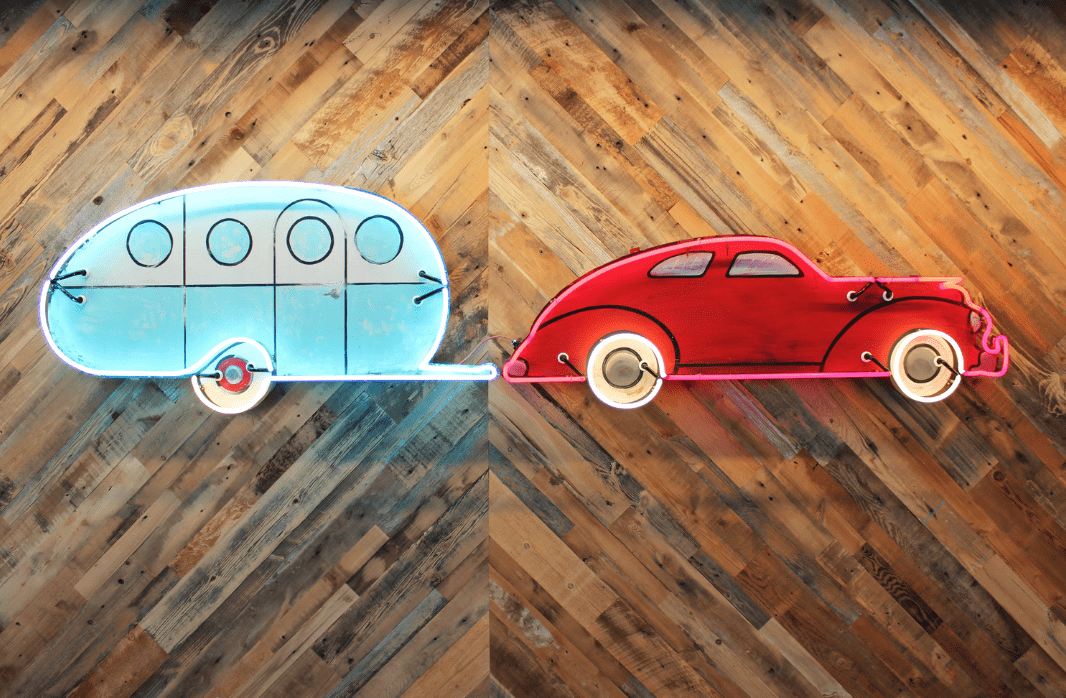More...

Rapid7, Austin, TX. Photo © Thomas McConnell.
In some sense, an appreciation for neon lighting is comparable to the sentiment that pinball machine, vinyl record, and high-wheel bicycle fanatics all share, although none of these passions are the most efficient technologically, nor the most practical. They just feel better.
This is a feeling that Gary Bouthilette, IA Senior Director of Lighting Design, can relate to. “Similar to genuine incandescent filament lamp “light bulbs”, there is no fully satisfying replacement for real neon lighting, even with advances in LED technology,” he says. “The 360-degree light it emits is simultaneously intense, yet soft, and somehow never fails to draw the eye.”
While often tasked with supporting IA design teams with the latest in lighting technology, the IA lighting design team appreciates the opportunity to embrace a previous generation’s method of attracting attention. As Bouthilette explains, the methods of the past can’t be 100% adopted.
“It can be rare to run into an older neon artist or fabricator. In the old days, the neon shops would, of course, save the patterns they hand drew for use in other projects. The patterns would hang on racks or sit on shelves, sometimes for years, until they were needed. An artist would retrieve the required pattern, and generally the first thing he’d do is shake the dust off before laying it down and getting to work. Unfortunately, to make the patterns fire-resistant (hot glass was going to be placed on them), they were made partly from asbestos, and the dust flying off was partly airborne asbestos particles. And so, sadly, that’s one reason you won’t run into many artists who have worked with neon for thirty or forty years.”
For a technology that is over a century old, the science behind the neon lamp can be surprisingly difficult to grasp for someone without a degree in chemistry, which might come as a surprise when you consider that its invention predates that of the battery, phonograph, and many other simpler technologies.

Confidential Client, Seattle. Photo © Alex Grummer.
How Does Neon Lighting Work?
The invention of the neon lamp was the result of another, perhaps more impactful innovation, George Claude’s process of air liquefaction. Developing a process whereby gasses could be converted to liquid via cooling and reheating allowed him to create large quantities of pure neon. This noble gas had been discovered several years earlier and demonstrated unique qualities when exposed to electricity. However, because of the difficulty in obtaining pure neon, the neon lamp wouldn't be patented until more than a decade later.

Confidential Client, Seattle. Photo © Alex Grummer.
Once purified neon was obtained (via the capture of runoff gasses emitted from the liquefaction of air), Claude placed it inside enormous glass vacuum tubes not unlike today’s fluorescent bulbs. He then ran an electric current through both ends of the tubes. Later iterations of the tubes run the current through only one end but the result is the same – a bright orange/red light.

Confidential Client in Austin, TX. Photography © Leonid Furmansky.
While most people associate a host of colors with neon lighting, in actuality, pure neon discharges only an orange-red light. When electrons in atoms like neon get excited, they discharge light energy in fixed-size bunches called quanta. The size of the light wave correlates to how the human eye experiences a given color; a larger light wave might appear as blue, while a smaller wave might appear red. In most neon lights, any other colors (e.g., purple, yellow, etc.) can be obtained by mixing gasses.
If this is difficult to envision, consider how fireworks are made. When particular metal salts are burned in a firework, they give off a different color. Red fireworks come from strontium or lithium salts, blue comes from copper, orange from calcium, etc. Neon lighting relies on a similar process.

Confidential Client, Seattle. Photo © Alex Grummer.
As designers quick to explore the newest lighting technology, we still appreciate the neon light. It’s not that efficient when it comes to energy consumption, and it’s not the most practical way to light a room. But neon has many characteristics that make it easy to love. For example, it is uniquely durable, and can burn for 50+ years if left on.
In some ways, neon signs are a uniquely American experience. After WWII, no other nation embraced neon signs quite the same way as the U.S. Ultimately, it’s probably neon’s aesthetic qualities and a sense of nostalgia that most endear neon light fans and IA designers to this century-old tech, and help create small moments of escape in workspace and retail environments around the world.
Care to Learn More About Our Lighting Philosophy?
Then you'll enjoy this blog called "Expertly Designed Lighting: Essential to Successful Interiors."
We look at images from past IA projects, talk with our in-house lighting design team, and open some science textbooks to investigate neon lights. We look into how they work, why they're still around, and why they're so easy to love.



